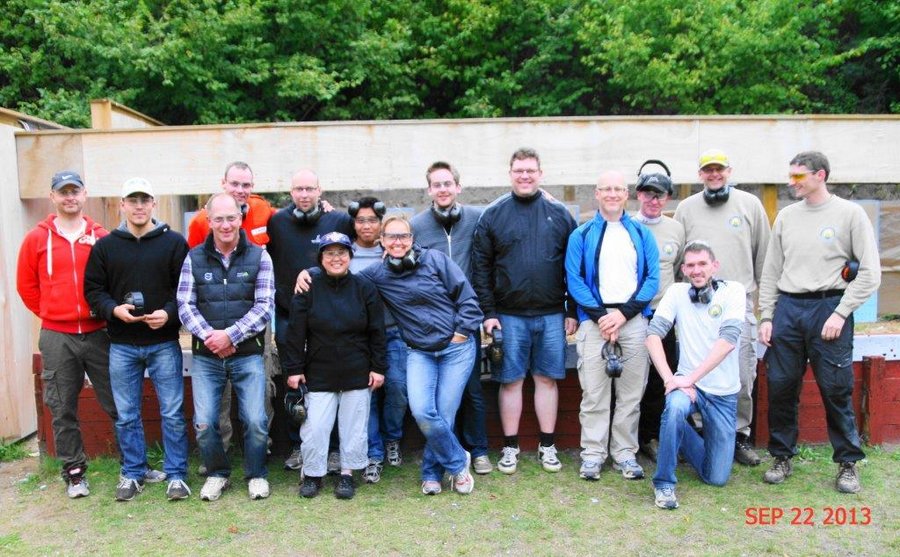
POMW III – POMW goes ballistic
By Martin Renshi, autumn 2013
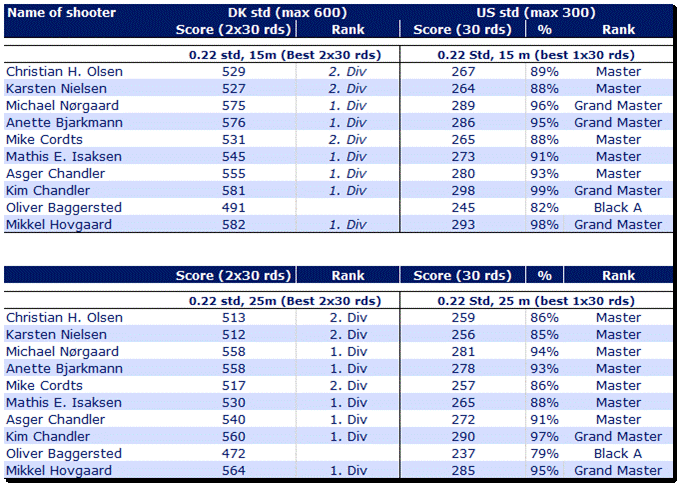
POMW III overall results
The dust has once again settled over Hanebjerg near Hillerød, as the POMW gun project has come to an end. Only Kimu Sensei continues, for the rest of the year, on the uncompromising road to become the complete POMW shooter. For everyone else, it means that the POMW gun course, and the recently completed POMW 3 game them a competence on equal terms with other KYU skills in Yakami Shinsei-ryu. However, there is a significant difference compared to Yakami Shinsei-ryu’s other skills; shooting is actually simple and straightforward. There will probably be many who do not agree, but shooting is basically about aiming, firing and hitting the target – more or less accurate. This is the case for short distances i.e. between 3 and 500 metres. At 500 metres or more Mother Nature starts playing a role and there are very few who practices shooting at such a long distance. POMW 3 is the transition from the shooting ranges to the shooting terrain/IPSC shooting i.e. shooting ‘in practice’. For the participants it meant that they moved from the indoor range where we practiced precision shooting, to the outdoor and field shooting. The question then was whether the participants like Kimu Sensei and at a later stage the chief instructors could obtain equally remarkable results as in the POMW 2 course. Would Minouchi Sensei’s theory and thus Kimu Sensei argument be valid for the difference between martial sports and martial arts, and was Kimu Sensei’s POMW shooting technique bulletproof J also outside the shooting ranges? Can a student of the Yakami Shinsei-ryu martial arts, with the right attitude, learn the modern warrior’s metier in such a short time?
POMW 2 showed, as we know earth shaking results that echoed throughout most of the shooters world, not only in Denmark, but also abroad. The POMW project has been followed from abroad with great interest. The US military has tried a similar and very costly project, which did not give such significant results. To some, it is offensive that a person, with no shooting experience at all, can learn the essence of shooting as well as master the techniques in such a way that he or she can compete with the elite shooters both in the civil and military world, and on top of that, even teach others in an optimal way. To others it is a welcome gift and a golden opportunity, which they would give half the kingdom to get 🙂
As with everything else in this world, those who possess a core competence, and have spent a long time to get it, are keen to protect it, make it special, complicate it etc. Why? It’s human nature to want to make yourself special and unique. As written in previous articles, it was the principle of “who do you think you are”, big egos, individual interpretations and fanatical attitudes that first met Kimu Sensei and later the chief instructors when starting up the POMW project in Denmark. The succeeding participants were spared all of this, as Shindenkan now has its own rifle club, with shooting instructors and shoot managers. Some of these have already graduated, and some still in training. It should, however, be mentioned that each of the shooting instructors have between 15 and 35 years of teaching experience from tens of thousands of students nationally and internationally. This allows the Shindenkan students to focus on the essence of shooting, on equal terms with other multi-lane competencies at the KYU level in Shindenkan, applying the same learning principles and values, but most important of all, without the influence of big egos and the feel of inferiority!
POMW 3, also called “POMW PI – POMW Pistol Intermediate”, is the obvious continuation of the POMW 2, following the ‘thread’ designed and developed by Kimu Sensei. The first module was held Sunday 1 September, the second the 8 and the final on 22 September. The last two modules also served as shooting manager training for the two shooting instructors: Jens Hanshi-dai and Martin Renshi. Unlike the other POMW courses, the participants would experience outdoor shooting with all that it entails, such as weather conditions, lack of equipment, the conditions of the range, etc.
The participants started the first module of the POMW 3 a sunny Sunday morning at. 8.30. In the time prior to the course they had all been informed of the importance of training dry firing and exercising with dumbbells applying the position of the POMW shooting technique, so that they could continue the good work from POMW 2, and thus not have to start from scratch.
POMW 3 would be tough for the participants that were expected to fire at least 1200 9 mm shot and approximately 600 shots with a calibre 0.22. The participants that showed up early, helped finishing the construction of the range, which consisted of six targets, each of which had two rafts with IPSC targets which had a track target pasted on. In this way, the participants got accustomed to the IPSC targets.
The biggest difference for the participants were the safety procedures that are different from the DGI/DSkyU (DGI before DDS and DIF – the Danish shooting union) shooting and the outdoors DSF (DIF – DskyU – Danish sports shooter Association) procedures. All commands for loading, shooting and discharging were given in English, and not in Danish which was used in the shooting for the indoor shooting. However, they had become acquainted with these terms during POMW 1 e.g. when using the IPSC airgun. It was also the international commands from the IPSC that were used.
Before the shooting could start it was important that the safety was in place. The instructions were read by the participants and Kimu Sensei who as an overall range master and trained DIF DSkyU DSF IPSC Range Officer (IROA 1) begin to explain the rules. First and foremost, it was important to behave properly on the shooting range i.e. the handling of weapons and ammunition, and of course, being in control of your own safety by wearing protective glasses and hearing protection. For safety reasons, there was established a table where all the gun handling was taking place, i.e. inspection and loading of the gun. There was also arranged a separate charging table where all handling of ammunition and magazine was to be done. There were 10 participants, in addition to the chief instructors who were also took part in the course, and 3 teams of 5 people were established so that there always was a shooter (in the hole) to load for those firing (the shooter) as well as for themselves. There was also a chief instructor assigned as the safety instructor.
After completing the safety briefing and the creating of the teams, it was time for dry firing, which was also part of the safety procedure. It had been while since the participants (except for the chief instructors) had had a 9 mm in their hands, so everyone was a bit nervous. Kimu Sensei had designed a series of dry firing exercises in which the participants were to handle the pistol and review the loading, shooting and discharging procedures according to the POMW shooting technique and the proper POMW Tai sabaki 🙂
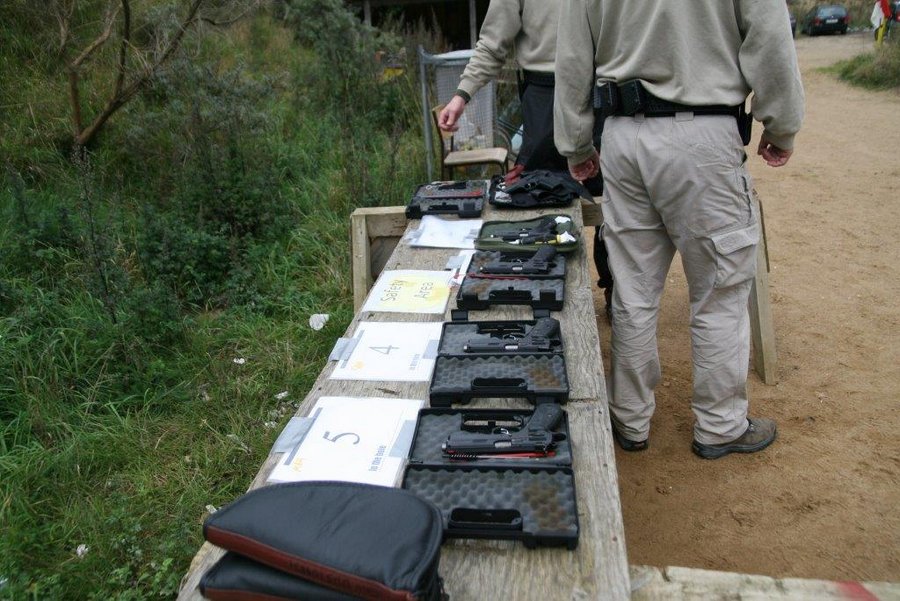
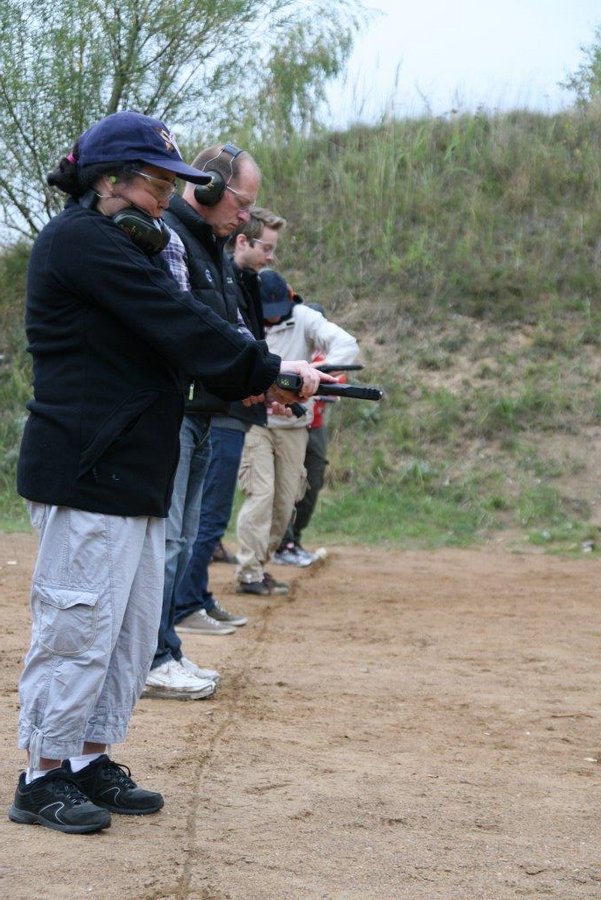
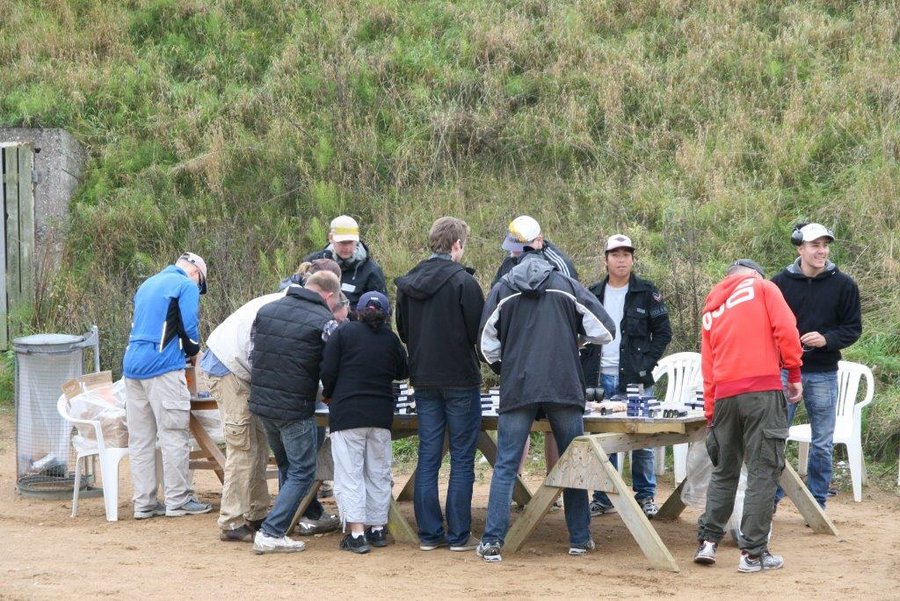
Kimu Sensei had throughout the POMW project made comparisons to martial arts and it is of course also valid for the basic handling of a weapon. It was obvious who had been practicing at home with the toy guns and who not and Kimu Sensei took this into account when making the teams. After the instructions for handling the change of pistols, the rotation of shooters, the supply and control of ammunition, we were able to keep up the pace, which was needed since many shots were to be fired that day.
The first shooting assignment was to fire the pistol and find your aiming point with the pistol at your disposal, lent to you by courtesy of the chef instructors. We did it this way as SDKskyt has not yet approved the 9 mm association pistols. At the same time it was important that the participants were acclimated to stand outdoor, where you suddenly get wind in your hair, sun in your eyes or rain in your face as well as showers of cartridges from the shooter next to you.
During the first few shots, the participants had the opportunity to revisit the POMW shooting technique i.e. ‘every shot counts’. Kimu Sensei went from one participant to another and corrected our most obvious mistakes so that we would not repeat those during our next shooting. As mentioned earlier, there were glued points marks on the IPSC targets, so that the participants could get used to the IPSC targets, so they would start with something familiar and then move from point shooting to range shooting i.e. instead of 10s, 9s and so forth it was alpha, charlie and delta zones. The shooting went really well and Kimu Sensei was impressed with how well the shooters did. It went so well from the short distances (7 m), that Kimu Sensei increased the distances to 10, 12 and 25m during the following shooting. It was important for the shooters to find out that the longer the distance, the more time they needed for the aiming or as Kimu Sensei says “You should be fast with everything except when you pull the trigger.” When the first module came to an end Kimu Sensei was still satisfied and the pace had been satisfactory. The targets also gave a clear indication: 75-90 % of the shots were scattered in the designated zones. <
Kimu ended the day by praising the participants for their attitude and their focus during the shooting. He was convinced that they after all their efforts would feel battered the following day 🙂 They had, after all, fired about 450 9mm shots, which according to DGI´/DDS studies is the equivalent to several years of shooting for the average Danish shooter. At this point, the participants were also asked to practice dry firing every day at home and to try to be in the “shoot at” so the attitude and focus would be maintained for Module 2. Kimu also advertised that there would be transition shooting and reset, which is more advanced shooting.
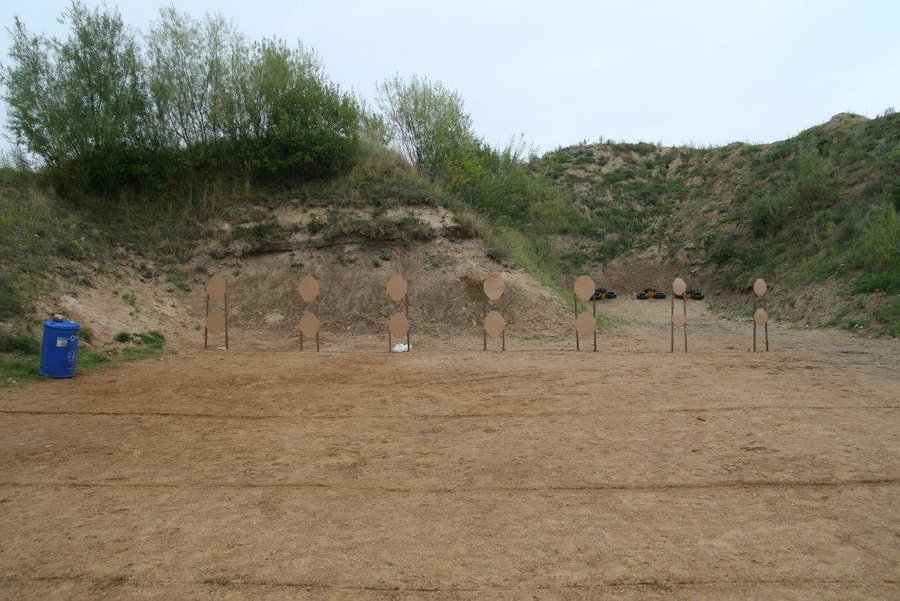
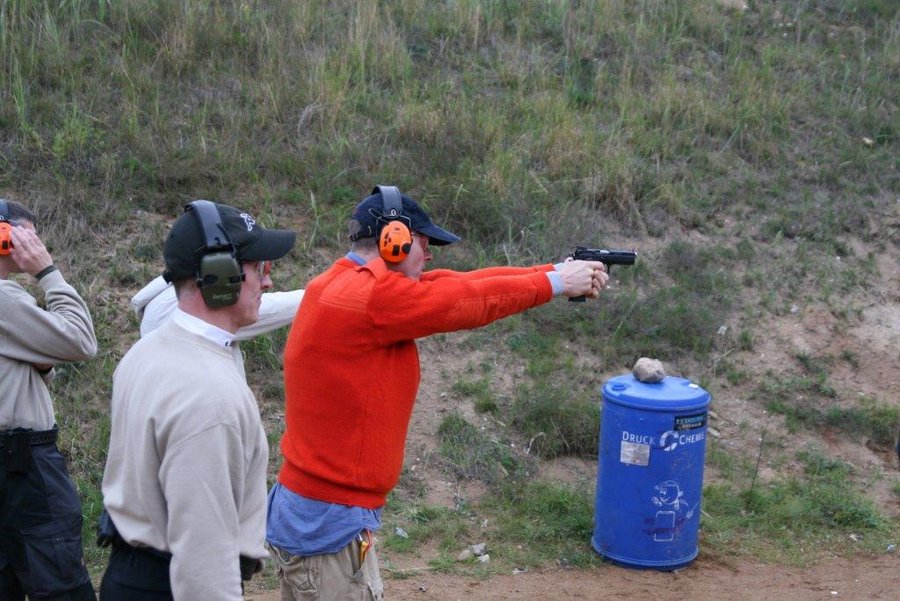
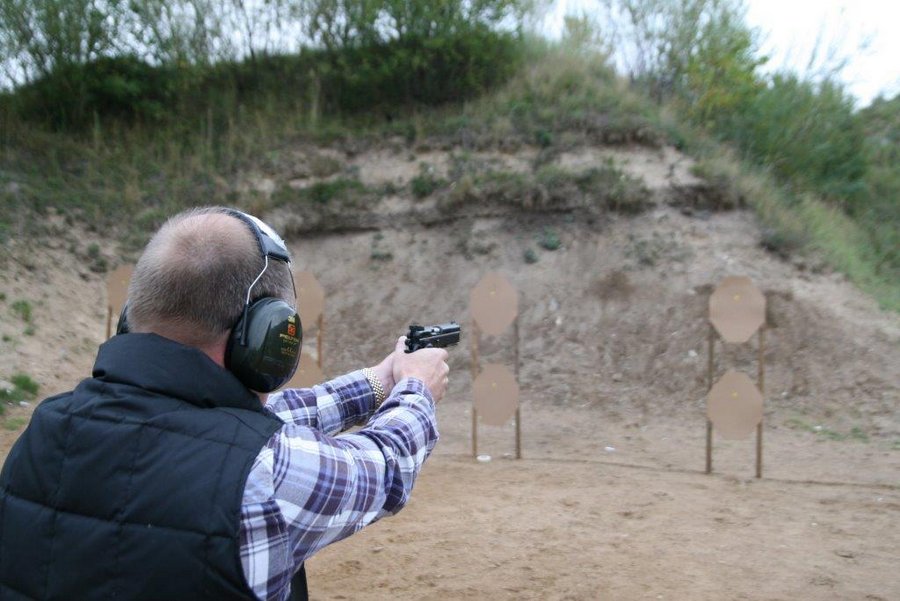
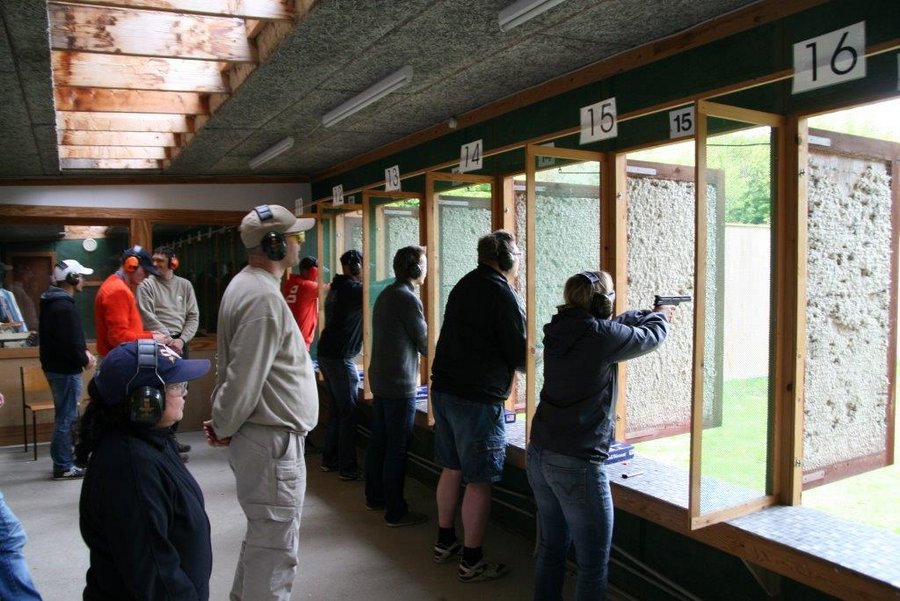
On the day when the participants met for the second module of POMW 3 it was once again a nice and sunny day. During this module Martin Renshi was to act as the shooting manager for the first part and Jens Hanshi-dai for the last part. Doing it this way, the courses in Shindenkan also work as management training for the next person in line. The course was again built up in the “hole” on Hanebjerg but with 2 targets placed on top of each other for each target. The first part of this module took place in the “hole” and the second part – after lunch – was spent at the shooting range, where we once again were to train the POMW 2 range shooting. Before the first shot was fired at 9.00, the gun handling and safety procedures were repeated. We began by training from an ever increasing distance, but this time without the point marks glued to the IPSC targets, which meant that we were firing on ‘real’ IPSC targets. The shooters were still doing well and it was obvious that they had become more familiar with the 9mm pistol and that the nervousness has gone. This enabled them to be more accurate in their shooting and they obtained a very high alpha percentage.
Kimu Sensei then continued with the transitions shooting. This was of course trained at a short distance only, where the transition between the objectives is the greatest, and therefore makes the most sense. The participants had previously tried this with an airgun and plastic bullets as well as the SIRT Laser Gun, but never with a 9 mm. Their training in the interim period helped them a lot and it went pretty well.
There were, of course room for improvement, and Kimu Sensei corrected and advised each shooter. The challenge of transition shooting is to regain the aim after you have moved the gun to a new target. The recoil is also a challenge, but it can also help you regain the aim if your timing is correct. Normally everyone has a ‘good side’ and a ‘bad side’ i.e. it is easier to switch targets either from right to left, or the other way around, and this was also true for most of the participants.
The shooters next challenge was transition shooting, both horizontally and vertically, i.e. the first shot is to be aimed at the bottom of the target, then either from right to left or the other way around, and finally at the target at the bottom again, a total of four shots. Throughout the process, it is important to keep the flow constant i.e. the time between each shot must be the same, whether you move upwards or sideways. If the sound could be heard there should be no difference on the 4 shots intended for the 4 different targets. The time between the firing is called split time, and it is supposed to be consistent. To minimise the split time and thereby be enabled to increase the speed and still be accurate you should practice the “reset”.
Reset is described previously in other articles, but in short it means that you use the gun’s mechanical construction when pulling the trigger. About 1/4 of the trigger has a clearance when the gun cock is triggered, i.e. reset only works with single action. This clearance can be “triggered” before you take aim and fire the next shot, and thereby you avoid wasting time.
Kimu Sensei demonstrated the reset for the participants and he said “I’m a little rusty as I focus on the POMW long range”. He fired, however, within 2 seconds 6 fairly accurate shots even as transitions at 15 m. Later he did the same with an entire magazine of .22 shots on 4 targets in 4-5 seconds, all placed in the alpha zone, all with the same split time. This made some very experienced marksmen from another rifle club to gape, and to say it was the fastest emptied magazine and precise firing they had ever seen, including shooting in Hollywood movies. They asked whether Kimu Sensei was a professional international chief instructor! Kimu Sensei did not reply, but gave them a polite and modest smile. It is not the first time that very experienced marksmen both from Denmark and abroad have said something similar about Kimu Senseis POMW demonstration firings. We have all witnessed this several times J. The first time he was noticed internationally was after 10 months of POMW shooting. Please read’ The Great One – Day of Steel. After this it went really fast in all shooting disciplines worldwide with the “real tough boys and girls”. It is just like Kimu Sensei wants it: “To be is more important than to believe.”
As the last exercise of the day, the shooters were allowed to try a reset in the “hole”. Most of the participants had success, but several encountered some challenges with the motorics, which the reset is demanding, as you cannot leave the hammer halfway and you need to feel the subtle click of the trigger as propagated to the pulp of the index finger. But fine tuning your techniques is just yummy for practitioners of Yakami Shinsei martial arts.
After collecting the cartridges, the participants went to the shooters cottage and the shooting range. After a short lunch it was again time to train precision on the shooting lane. It was at this point that Martin Renshi took over as leader of the shooting after he had made a decent effort in the “hole” as assistant chief instructor. After lunch, while the preparing the indoor range, Jens Hanshi-dai and Martin Renshi went through a so-called “field strip” and the cleaning of a CZ 9mm pistol, where the participants were allowed to participate in the cleaning of the pipe, rail, etc. which took about 20 min. Next, it was time for precision shooting. This too was according to the POMW 2 standard, so we returned to the DSKU rules and commands in Danish. Martin Renshi did not have complete control over the planning, and with a delay, the point shooting began. It was a rather difficult shift for most of the participants, to move from field shooting and the IPSC targets to precision shooting and points. By now everyone was exhausted, so the day ended a little earlier than expected and without shooting the .22. We still had plenty to practice for the next time, especially for the shooting manager Martin Renshi who received constructive feedback. It was concluded that several areas had to be improved, so that the course could run more smoothly and enable the participants to concentrate 100% on perfecting their shooting and continue their development.
The third and final module was also an examination in POMW 3. Similar to the other 2 modules it began an early Sunday morning and everyone was briefed in advance by the new shooting leader. He was still undergoing training for the examination of others. Jens Hanshi-dai therefore had to get up very early so that he could help prepare the range etc.
Kimu Sensei began the last module at. 08.45 sharp by dry firing. He repeated the whole safety procedure regarding the loading, shooting, discharge, etc. After that we picked up where the previous module ended i.e. training of reset. Only then we began the shooting on IPSC targets from various distances, doing resets, and firing more shots per series. Subsequently, the participants trained transitions also with reset with the aim to hit the same split time between each shot. It was obvious that the split times and transitions had improved compared to the 2 module. The participants had also enhanced their ability to take the time needed when the distances increased. In addition, the participants had gotten used to outdoor shooting and Kimu Sensei had ‘cured’ all fright of recoil so that they could relax and focus on their shooting.
In fact it went so well that Kimu Sensei decided that the participants should be allowed to try shooting around barricades, as the time in ‘the hole’ had been extended in agreement with those who were to shoot next. To this purpose, two barricades, in the form of wooden doors in portable frames, were brought into the shooting area and placed in front of some of the goals. First, the participants were to dry fire. As you must not withdraw from the holster or move while firing, the participants had to be in a standing position behind the barricades, lean to the side and lift the gun from a 45 ° angle before firing. This was as close to IPSC and practical applied shooting as it could get without being proper IPSC. In Denmark (as the only country in the world) IPSC must only be practiced if you possess an A license.
After all participants had practiced dry firing, they got the permission to shoot around the barricade, under supervision and security by Kimu Sensei. Judging by the results it seemed all the participants had spent all their lives on doing this sort of shooting.
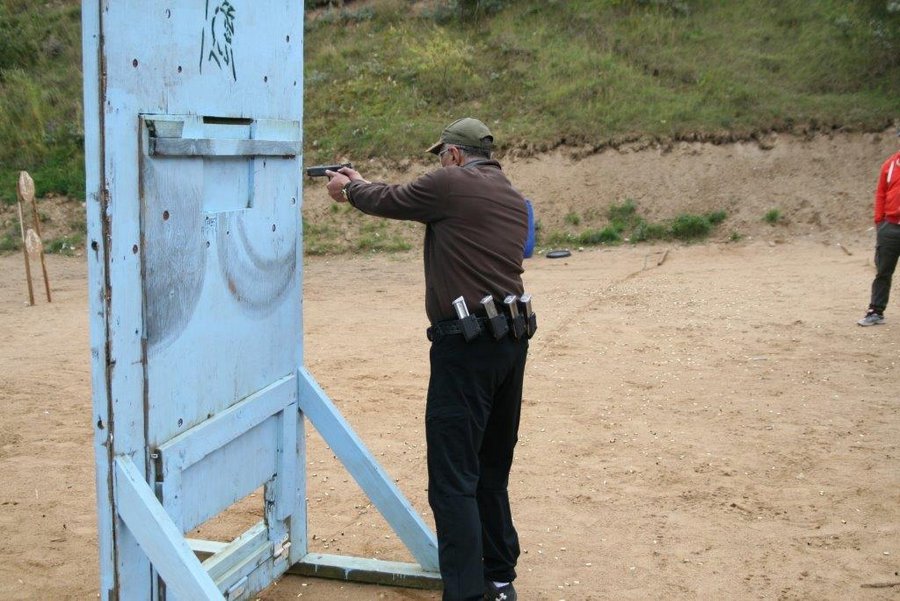
Kimu Sensei demonstrates dry firing and shooting around a barricade
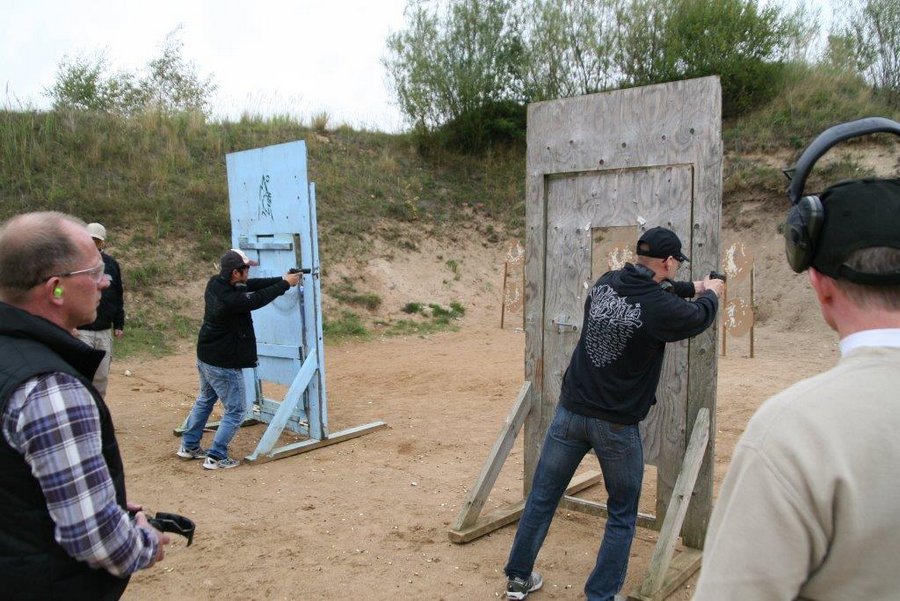
The participants practice dry firing around a barricade
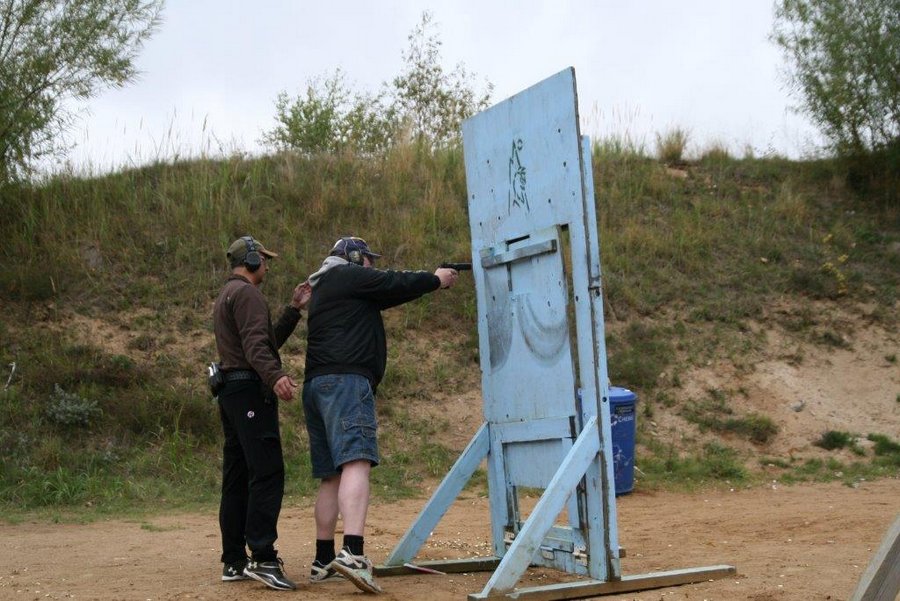
A participant shooting around a barricade under supervision and saftey guidance by Kimu Sensei
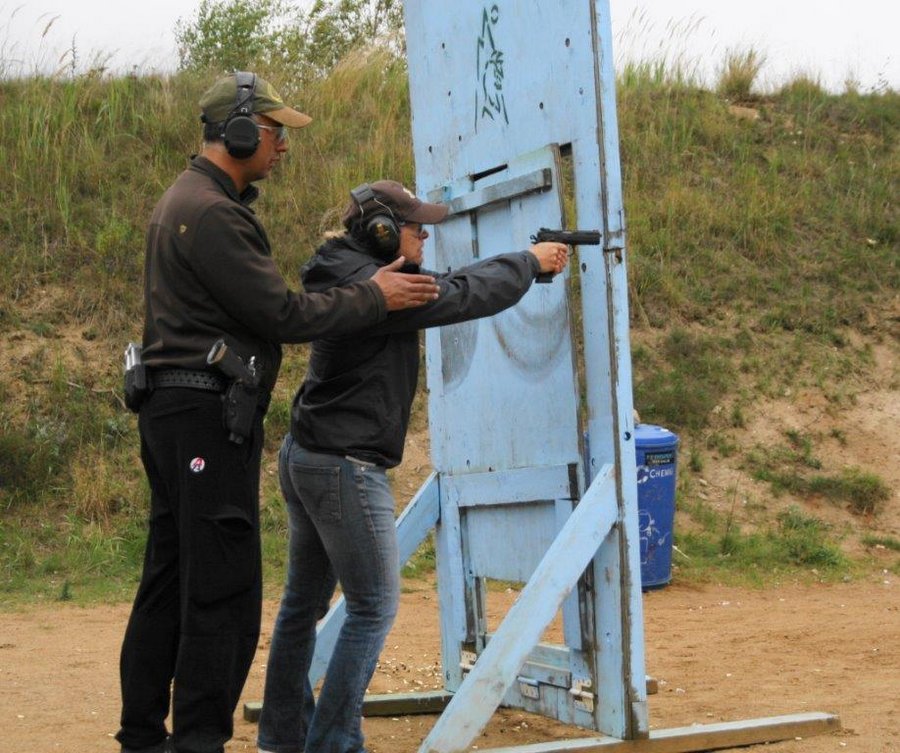
A participant shooting around a barricade under supervision and saftey guidance by Kimu Sensei
As the last exercise Kimu Sensei wanted the participants to understand that one can actually shoot pretty far with a pistol. For this purpose there were placed 3 metal targets (10 cm and 15 cm target) in the far corner of the “hole”, which was equivalent to approximately 50 m. Here, three participants at a time were allowed to use their last 9mm ammunition, with the result that the nicely painted yellow targets quickly turned grey again. It also proved that you can hit the target from a great distance, as long as the technique is correct. It may well be that only 80-90% of the shots hit the correct zone, but that is a fairly good result for a quick shooting competition 🙂
We had a quick lunch near the indoor range that was to provide the frame for the end of POMW 3. Jens Hanshi-dai was set on a serious test as shooting manager during the exam. Everything ran like clockwork, so there was a huge difference from module 2, this was also expressed in the participant’s feedback. The only question was whether the participants could shift from field shooting in “the hole” to precision shooting at the shooting range, and whether the many good shots regarding the split time, transitions and reset according to the POMW shooting technique and the right attitude would give the wanted results. It worked like a charm!
In the table below you can see the difference from POMW 2 to 3 POMW. POMW 3 has created great results and there is a difference between POMW fundamental and Intermediate shooters. POMW 3 has given the participant far more experience, better precision but also increased the swiftness.
All results in the table below were initiated and completed in 3-5 minutes, which is really fast in comparison to what the traditional shooting prescribes. But here the POMW says that it is the results, the outcomes and the competence in a holistic perspective that counts.
The POMW 3 training was also what placed two of the chief instructors as number 1 and 2 when they passed their DSkyU DSF A license, amongst shooters with both police and military backgrounds with up to 35 years of experience. It was also what Kimu Sensei pointed out in his final PowerPoint presentation summarising the POMW process. POMW is a unique training program that has no equal. If you take the comprehensive POMW education, you will reach a level, where you will be able to shoot with the world’s best military as well as civilian shooters within their specialties.
POMW 3 can rightly be said to be a huge success, both in terms of the participants’ results, but also the speed at which these results are obtained. The tables above speak their own language – the data are telling the truth!
POMW II shooters on the POMW III course, results and improvement benchmarks
- Efter POMW III skyder 60 % af deltagerne, Dansk 1. division indenfor mindst én skydedisciplin
- Efter POMW III skyder 30 % af deltagerne, Dansk 2. division indenfor mindst én skydedisciplin
- Efter POMW III skyder 10 % af deltagerne, Dansk 3. division indenfor mindst én skydedisciplin
- Før POMW III var der ingen POMW II skytter som skød dansk 1.division.
- Før POMW III var der én POMW II skytte som skød dansk 2.division, resten 3 og 4 division
- En gennemsnitlig forbedringsprocent på ca. 12 % fra POMW II til POMW III
- Efter POMW III har mindst 90 % af deltagerne skudt på US-masters niveau indenfor mindst én skydedisciplin
- Efter POMW III har mindst 40 % af deltagerne skudt på US Grandmasters niveau indenfor mindst én skydedisciplin
- Forbedringsprocenten er afgørende for om skytten skyder 1.division eller ”4.division”
- Skuderfaringen samlet for POMW II og POMW III er knap 2.000 skud, – men mindst 20.000 tørtræningsskud. Iflg. DDS rapport skyder en dansk skytte gennemsnitlig ca. 240 skud pr. år, hvilket betyder at POMW III skytter omregnet har ca. 8-9 års skytteerfaring
Kimu Sensei has indeed found the essence of shooting; he masters it and can pass it on. A Shindenkan martial arts student, with broad mind and the right attitude can learn this in an in very short time. POMW 3 is held on a lower level with regards to the martial arts terms, than first planned – from TG5 to TG3. Kimu Sensei always builds dynamic courses that can be adjusted along the way according to the current facts and circumstances. It has been proven that shooting in fact is very simple, which of course is consistent with the original purpose. In time of war the soldiers should be educated to be as effective in the shortest possible time. It is much easier to shoot than for example master the ken-jutsu and the mental learning process that lies in martial arts and later in martial sports. Therefore, it is also possible that POMW will be offered at an earlier stage in Yakami Shinsei-ryu if it fits more into the training plan, depending on how Yakami Shinsei-ryu moves in a dynamic world where nothing stands still.
Epoilogue:
As both a writer and a participant throughout the POMW project, I think it’s been an amazing journey. I am proud of the results we have achieved in Shindenkan, but I must admit that I was a bit sceptical in the beginning of the POMW project; what were we to do whit this shooting. The scepticism was quickly erased and I gave Kimu Sensei and the POMW all my confidence, which in my experience, is the most sensible. 2 ½ years after the POMW started, Kimu Sensei has shown me the path to quite reasonable results considering that I and 90% of the other participants had no shooting experience whatsoever before POMW. It has been an advantage since the shooting you either had learned elsewhere or by you of course would have been wrong. The POMW shooting technique is the direct road to mastering the relative simple discipline that shooting is on the short distance. But shooting should not be underestimated as a tool, if used like this. Shooting has a nice consequence, just as kumite has it, and it is that process together with the attitude, which we can use in Shindenkan just like Minouchi Sensei pointed it out. The old warrior can learn the modern warrior’s core competences in a relatively short time, but not the other way round. Kimu Sensei has created a project and course that proves just that. Yakami Shinsei-ryu has been the 1000 year old skill that has enabled the participants to adapt to the modern warrior’s core competency – shooting. Shooting is a serious matter. We have had fun during the POMW courses, but always with a respect for safety. This will be shown in the maintaining of competencies in SDKskyt union that aims to be one of the safest shooter environments in Denmark. POMW is a milestone in Shindenkans story that not only has it placed us on the map of Denmark but also map of the World. Once again, I would like to say that I am feel very privileged to have been a part of this project.
Unload – show clear – holster…
Martin Renshi
For the shooting nerds
Results and benchmarks for POMW II “Fundamentals” vs. POMW III “Intermediate”


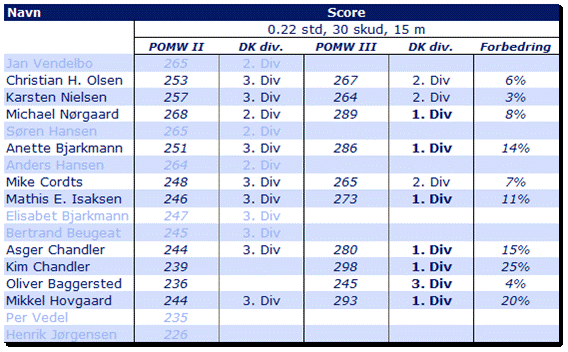
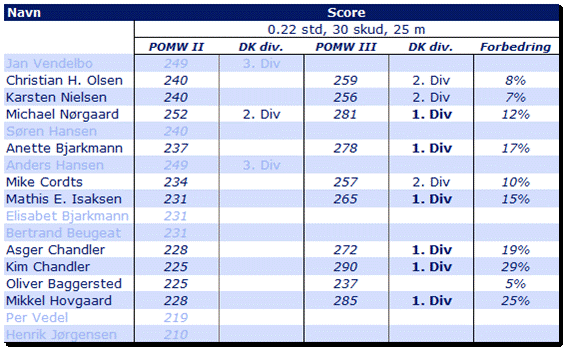
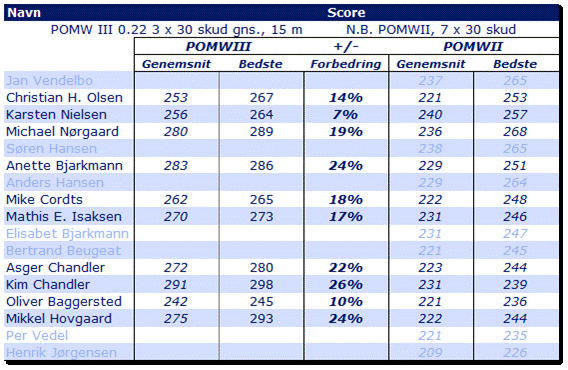
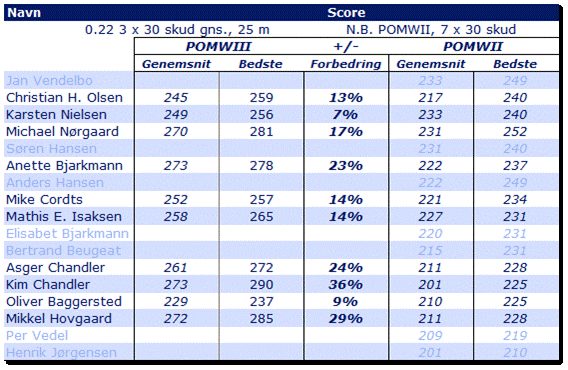
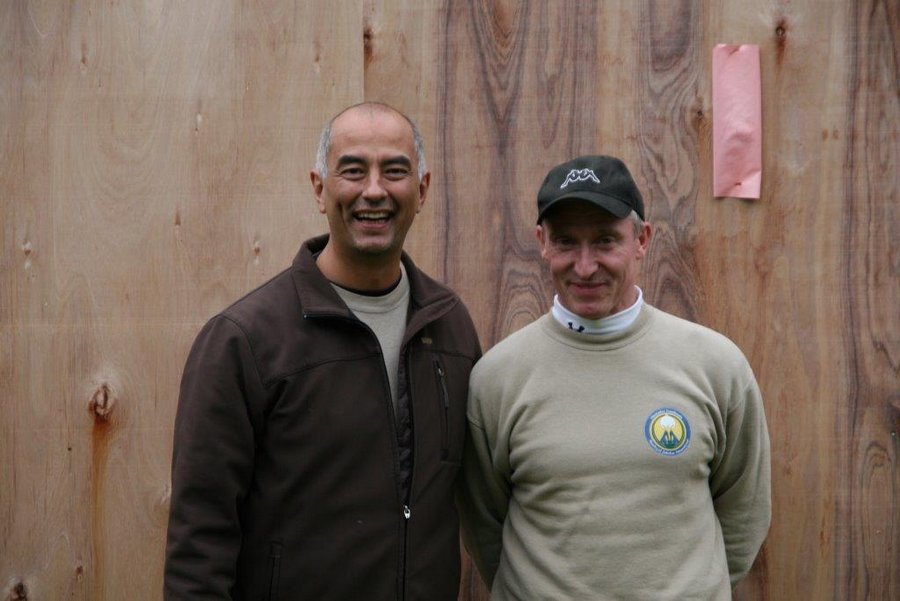
Jens Iversen, just passed as POMW II range officer

Four newly decorated POMW I assisting instructors – top 4 in POMW III